Bring Nature Home- Sue's Sunny Garden
by Sue Van Baerle
Part 1- Garden Planning & Design (Feb. 2023)
Part 2- Mulch, Edging, Paths, And Plant Selection (March 2023)
Part 1- Garden Planning & Design
How to Plan the size of your new garden and guesstimate costs
How many plants and the size of a new garden depends on the amount of time, energy and money you want to put into your project. If you plan for just plant plugs and mulch you can guesstimate $6/square foot in costs. If you want to include high cost species, new trees, concrete, natural stone edging, stepping stones, bird bath, fountain, sculpture or tool rental you will have those items as additional costs.
Time required can vary greatly. You could spend days or weeks researching and selecting plants, and days designing your bed lines. Or, you could purchase a kit where the plant selection and design layout have already been selected for you. Depending on your situation, you may need time to smother or remove existing vegetation, perhaps trench and install edging, transport your plants home, dig plant holes, plant and possibly add mulch or plant labels that document the species locations. After planting, you will need time to clean and recycle the plastic containers. And last, but not least, you will need time to water and weed into late fall. You may also want to take the time to collect and clean seeds so that you can expand your garden and trade seeds with friends for next year.
Plants: You don’t need to decide how big your garden will be right now but to give you an idea about garden size, we will look at two garden kits. This is one of several companies that sells garden kits. https://www.prairiemoon.com/garden-kits.
There are other nurseries closer to the Twin Cities with garden kits available and there will be resources for finding them later in this article.
Example 1 Garden Kit- Pollinator Patch Garden Kit - 18 plants for $119.00 plus shipping
Covers 40 to 50 square feet (Example: 7’ by 7’ garden bed which is about the floor space in a small bathroom or walk-in closet.) https://www.prairiemoon.com/pollinator-patch
Example 2 Garden Kit- The Colossal Pollinator Garden Kit - 50 plants for $189.00 plus shipping
Covers 120 to 150 square feet (Example 11’ x 13’ garden bed or about the floor space in a dining room or guest bedroom.)
https://www.prairiemoon.com/colossal-pollinator-garden-kit-50-plants
If you opt to purchase Individual plants, they are generally between $4.50 and $7.00 each. Depending on the species an individual plant might take less than 1 square foot or it might take 4 or more square feet. You can generalize at about 2 or 2.5 square feet per plant.
Create a rough sketches of your garden area
At this point, you do not need an accurate drawing of your new garden. Some quick sketches and an idea of your budget will help get you started. You can look up your address on Google Maps, zoom in and create a quick sketch your house and garden area. Make a graphic to show North, South, East and West. As you plan your garden, it is better to start small, learn and add more plants next year. If you find you do not have enough time to water or weed, you may end up with more weeds than desired plants.
Designing your bed: Think of your early sketches not as a final design but as a way to figure out what you want. There is plenty of time to finalize garden size, shape and plants. Keep your money and time budget in mind as you decide on size. The size will also help you decide how many species you want to research. Additional resources, including planting templates and plant lists, can be found on BWSR's Lawns to Legumes website.
Thinking about what you want / need:
- Here are just a few common questions to ask yourself.
- Where do you currently walk to get to your shed, garage, patio etc?
- Do you want straight bed lines, curved bed lines or a mixture?
- What garden bed shape goes best with your home’s architecture?
- Do you want to add: a tree, large shrub, sitting area, sculpture, or bird bath?
- Do you want room for a vegetable garden?
- Will you view the garden from a particular window?
- Do you know where your underground utilities are? (More info later)
- Does your new garden shape create a lawn area that would be difficult to mow?
- Will the dog or your kids basketball end up in your garden?
- Is your garden inside a fenced area?
- Do you have problems with deer or rabbits?
- What area is in sun and what area is in shade?

Sue’s garden plan: My garden needs to pass the "neighbor test" in an area of well manicured lawns. I want to be able to see over my plants to the street, so I am looking for shorter full sun plants with a few taller species to add variety..jpeg)

I had two mature trees removed in 2019. The stumps were ground up and garden soil brought in to fill the low spots. (I will say more in another article about the current dangers of bringing in soil.) I started to transplant plants to the open ground without any plan; simply because it was easy. I had the plants and I did not have to remove lawn.

Sue’s tree sketches: In 2019, I created a sketch of where I might add trees. They are grouped together on the north side of the yard leaving a sunny area on the south side of the yard. I decided this sketch had too many trees and would shade the neighbor's yard. Instead, I chose to add two dwarf fruit trees and three native trees spread over the entire area.
In 2020, four oak trees sprouted in the open soil and an additional oak started in the spring of 2021. I decided to leave all five and change the design to accommodate them. In 2022, I wanted an unobstructed view from the front porch to the street. I also noticed that the prairie coreopsis (Coreopsis palmata) was spreading rapidly. I created another design to accommodate the young oaks, open the view, and move the coreopsis to the other side of the yard. The linear perimeter shape should make the garden look intentional and the rounded corners will make it easier to mow around. (See below for more sketches).
Sue’s Garden size and costs: I do not plan to use a garden kit this year because I already have many of the species offered in the garden kits. I am planning on adding between 50 and 200 square feet of garden space. So, I will need 20 to 100 plants at about $6.00 each plus tax or approximately $120 to $600 in plants. I may rent a chipper and create mulch with a friend of mine who will transport the chipper. Rental is between $125 and $250 depending on hours / days rented. I will use the chips on new and old paths and beds. I plan to continue using bricks on the walkway.
Sue’s $ Price tag: For 50 square feet of garden the total estimated cost for plants, mulch and walkway bricks is a wishful thinking low of $270.00 ($120 plants + $125 chipper rental + $25 bricks with no edging). It would be less expensive to purchase bags of mulch but I will use additional mulch to refresh other paths and gardens.
For 200 square feet with extras, the high estimated cost is $1,200 ($600 plants + $250 chipper rental + $50 bricks plus $300 extras - tree or shrubs, bird bath, edging outside perimeter of garden.) I can now use these estimated costs to decide how much larger I want to make the garden this year.
Time and energy Price tag: (this is a giant guesstimate)
The amount of time and physical energy depends in part on how I decide to kill / remove the lawn, how much buckthorn I mulch, and if I decide to add edging. It also depends on how long I research plants, how far I drive to pick them up. I will need to lay bricks, lay out the plants, plant, mulch, create labels, clean and recycle empty containers. The lawn removal, plant installation, mulching and clean up will hopefully take 3 hours a day for 3 (50 sq feet) to 12 days (200 sq. Feet).
Look at Plant Catalogs:
Bush Lake is USDA Plant Hardiness Zone 4B which is often simplified to Zone 4. There are many great nurseries with websites in our area. I chose to use Prairie Moon as an example because it has a large offering and extensive search filters.
A list of other native plant nurseries can be found at the Wild Ones Twin Cities website http://www.wildonestwincities.org/p/resources_20.html
Bluethumb https://bluethumb.org/plants/ is another good search engine for plant species information. Additional local resources can be found at the Wild Ones Prairie Edge website. https://www.wildonesprairieedge.org/resources.html
To have a native plant garden, you will want to double check that a plant is native to our area. At the Prairie Moon website, you can open up the range map on each species to see where in Minnesota each species is native. There are filters for Sun Exposure, Soil Moisture, Native Range (with a dropdown for Minnesota), Bloom Time, Bloom Color, Height, Advantages, and USDA Zone. You will not need the Germination Code unless you plan to purchase seeds.
Sue’s search filters example: https://www.prairiemoon.com/plants/
- Category - no selection or 3 Packs (no selection includes species available as seeds only)
- Sun Exposure - Full
- Soil Moisture - Medium Dry (I want minimum watering and I have sandy loam and a slope)
- Native Range - Midwest (with a dropdown select Minnesota),
- Bloom Time - no selection
- Bloom Color - no selection
- Height - zero to 3’
- Advantages - the house with the heart (recommended for home gardens) and the Deer with the line through it. (Deer are less likely to eat)
- USDA Zone - 4
The results from this filtered search give me a great place to start looking at the shorter plant species that will work in my front yard. I’ll change search criteria, for example, I’ll select Bird Favorite and Bee Favorite. Don’t forget to click on the species and open up the Range Map for each species. You may want to start by looking up the species that come in a kit. The kits will familiarize you with some of the most popular natives for home gardens. Learning everything about all the natives can be very time consuming. Keep in mind the amount of space, time and money you want to budget. How many species do you want to add this year?
Good Luck and Happy Garden Planning
Workshop?
If there is interest, we could do an in person workshop on design and plant selection in March or April. Please email Sue if you are interested in attending a workshop at our chapter.
Rough Sketches of Bed Lines and Paths

Sketch- Curved single bed with path
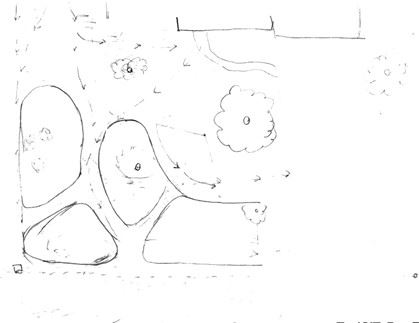
Sketch- Island design with lawn paths
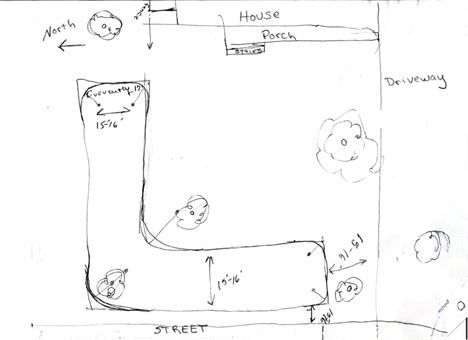
Sketch- Linear design
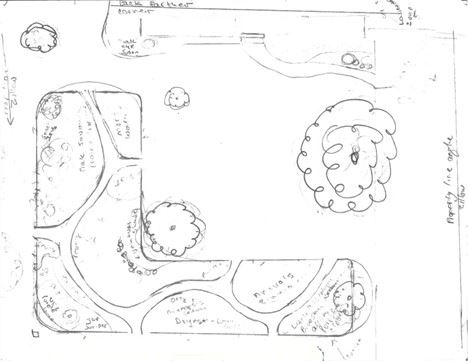
Sketch- More complete Linear design with curved paths
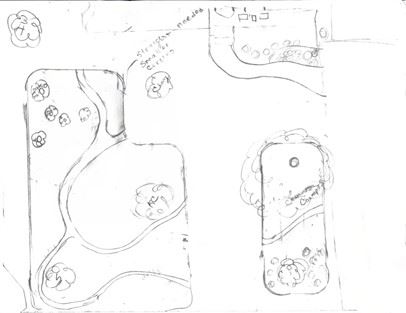
Sketch- Unobstructed view, Making room for oaks, intentional look, round corners for easier mowing
Part 2- Mulch, Edging, Paths, And Plant Selection
Mulch: You may want to mulch your new garden, or you could add a layer of ground cover plants to help stop weeds. Mulch also helps retain moisture, which helps your new plants. You can transport bags of mulch in a car. To transport larger quantities (by the cubic yard) you would use a pickup truck or pay to have mulch delivered. Unless you are ordering multiple cubic yards of mulch, delivery greatly increases the price per cubic foot. One popular mulch option is shredded bark mulch because the long strands tend to stay in place on a slopes when small chips would wash out of the bed. A bag of mulch generally holds 1.5 to 2 cubic feet and sells in box stores and garden centers for about $4.00 and up. A cubic foot of mulch is 1’ wide, 1’ deep and 1’ tall. One cubic foot of mulch applied 12 inches (1’) deep would cover one square foot of ground. If you apply mulch 4” or 1/3 of a foot deep; one cubic foot would cover 3 square feet, a 2 cubic foot bag would cover 6 square feet. Applied 2” deep or 1/6 of a foot; one cubic foot would cover 6 square feet, and a 2 foot cubic bag of mulch would cover 12 square feet. In general, most native plant gardeners do not add mulch after plants are established. Plants will fill in and die back, creating their own mulch. We also have many ground nesting pollinators, and adding mulch year after year can make it difficult for them to nest. Avoid dyed mulch or treated mulch- the dye usually washes off in the first rain and can contain other things that are bad for our environment. With mulch, the more natural, the better.
Cubic Yard of Mulch: One cubic yard of mulch is 3’ wide x 3’ deep x 3’ tall (3 x 3 x 3 = 27) so 1 cubic yard of mulch equals 27 cubic feet of mulch.
Example: A 10’ x 12’ garden has 120 square feet of space. Covered 4” deep in mulch, it would need (120 / 3 = 40) 40 cubic feet of mulch. To convert from cubic feet to cubic yards, 40 cubic feet / 27 cubic feet per cubic yard = 1.48 cubic yards of mulch. You would purchase 1.5 cubic yards of mulch.
Edging: If you want to add plastic, bricks, or aluminum edging, you 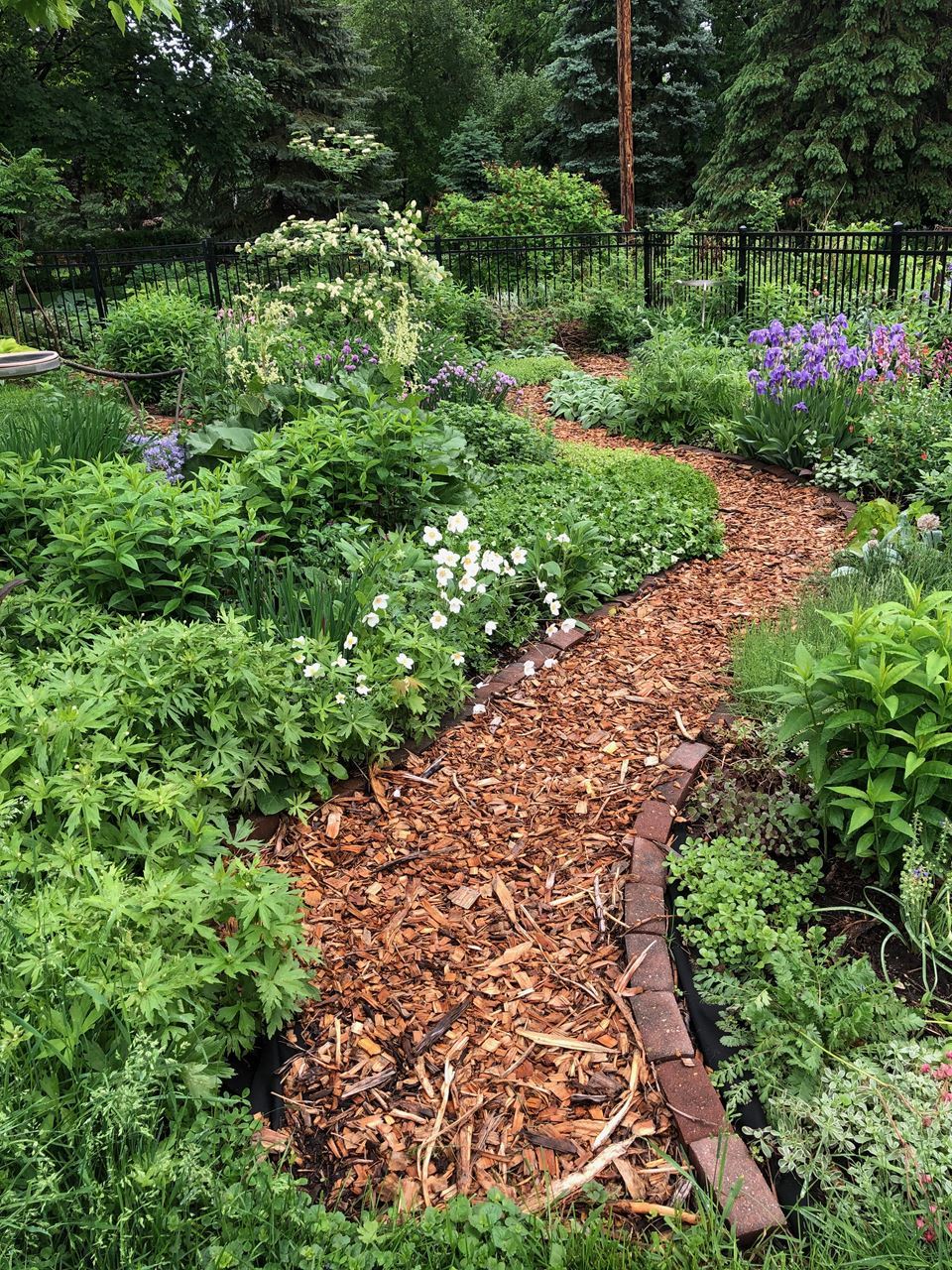 will have to add that cost. Plastic edging lasts a long time but takes effort to dig the trench and install. You can purchase it coiled or in long straight pieces. If you are doing lots of long straight borders, straight pieces are easier to work with. If you want a long continuous curve, the coiled edging comes in much longer pieces. When you want to remove edging from your garden, it pulls out but can have permanent bends making it hard to reuse and hard or impossible to recycle. Sunny beds surrounded by lawn are more likely to need edging than shady gardens, due to the speed the lawn will spread into your garden. You can go without any edging if you have the time to dig / repair a small trench between the garden and lawn two or three times a summer. Prices for plastic edging vary greatly as does the size and thickness of the plastic. Prices start at about $.65 a running foot and go up over $1.50 a running foot. Bricks and concrete edging start at a similar price per running foot. Prices for natural stone are much higher.
will have to add that cost. Plastic edging lasts a long time but takes effort to dig the trench and install. You can purchase it coiled or in long straight pieces. If you are doing lots of long straight borders, straight pieces are easier to work with. If you want a long continuous curve, the coiled edging comes in much longer pieces. When you want to remove edging from your garden, it pulls out but can have permanent bends making it hard to reuse and hard or impossible to recycle. Sunny beds surrounded by lawn are more likely to need edging than shady gardens, due to the speed the lawn will spread into your garden. You can go without any edging if you have the time to dig / repair a small trench between the garden and lawn two or three times a summer. Prices for plastic edging vary greatly as does the size and thickness of the plastic. Prices start at about $.65 a running foot and go up over $1.50 a running foot. Bricks and concrete edging start at a similar price per running foot. Prices for natural stone are much higher.
Sue’s mulch plan: Ground cover plants will be added, but I’m not yet sure which species. I currently have native strawberry which is spreading quickly through the bed and right out into the lawn. I am OK with that, but my neighbor may not be happy about that. In planting areas where I decide to use mulch, I will apply it 2” deep. It only needs to stop the weeds until the plants fill in and shade the ground. I will also apply mulch to the garden path. I plan to rent a chipper and chip a friend’s buckthorn to use as mulch. I plan to only use the buckthorn mulch in the paths, as that nasty buckthorn is allelopathic, which means it exudes chemicals that prevent other plants from growing. Buckthorn mulch may have the same effect. My cost will be the expenses of renting a chipper and my time to chip and move the mulch. See my caution about jumping worms at the end of this month’s entry.
Sue’s edging plan: I have tried plastic edging, bricks laid on top of my 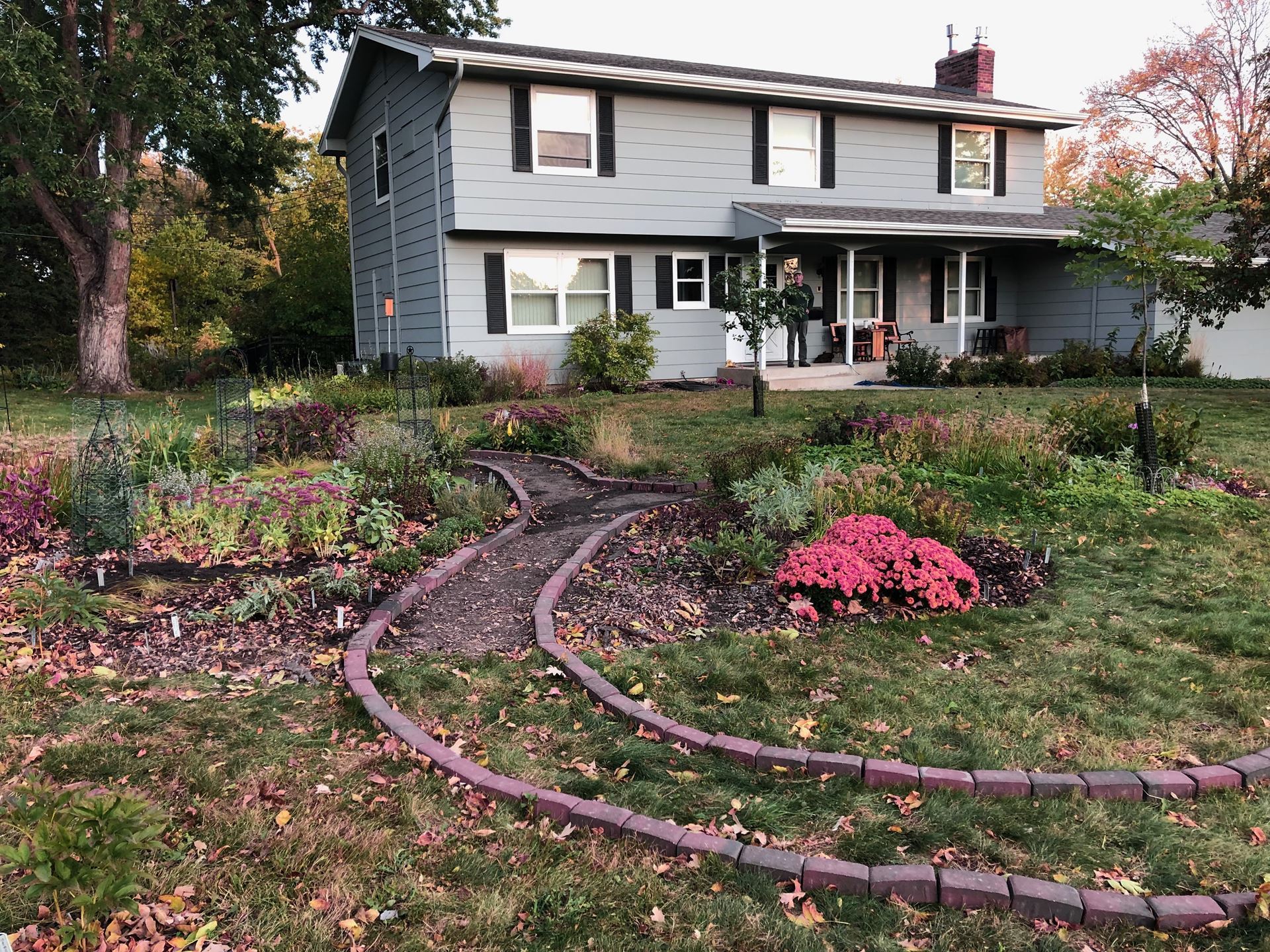 sandy loam soil, edging and bricks laid together, and digging a small trench around the garden beds. Sometimes the bricks look terrible because critters dig beneath and move them around. I generally re-lay them the second year and sometimes again after 4 or 5 years. The plastic edging and brick laid together stays in place much longer but is harder to change. I no longer want to purchase plastic that may end up in a landfill, so I will continue to build the walking path with bricks. I can easily pick the bricks up and change the paths. I also use the bricks (or a garden hose) to help me think through where the path will go next year.
sandy loam soil, edging and bricks laid together, and digging a small trench around the garden beds. Sometimes the bricks look terrible because critters dig beneath and move them around. I generally re-lay them the second year and sometimes again after 4 or 5 years. The plastic edging and brick laid together stays in place much longer but is harder to change. I no longer want to purchase plastic that may end up in a landfill, so I will continue to build the walking path with bricks. I can easily pick the bricks up and change the paths. I also use the bricks (or a garden hose) to help me think through where the path will go next year.
I already have garden cloth to put under the mulch to slow down the weeds. If I needed to purchase garden cloth this year, I would try natural burlap. This website has garden tools and supplies including burlap. I don’t know how long it will last.
About 15 years ago, I decided on a smaller red and black brick that would be easy for me to move well into old age. I went with a standard brick from Patio Town in the hopes that I would be able to match it for years to come.
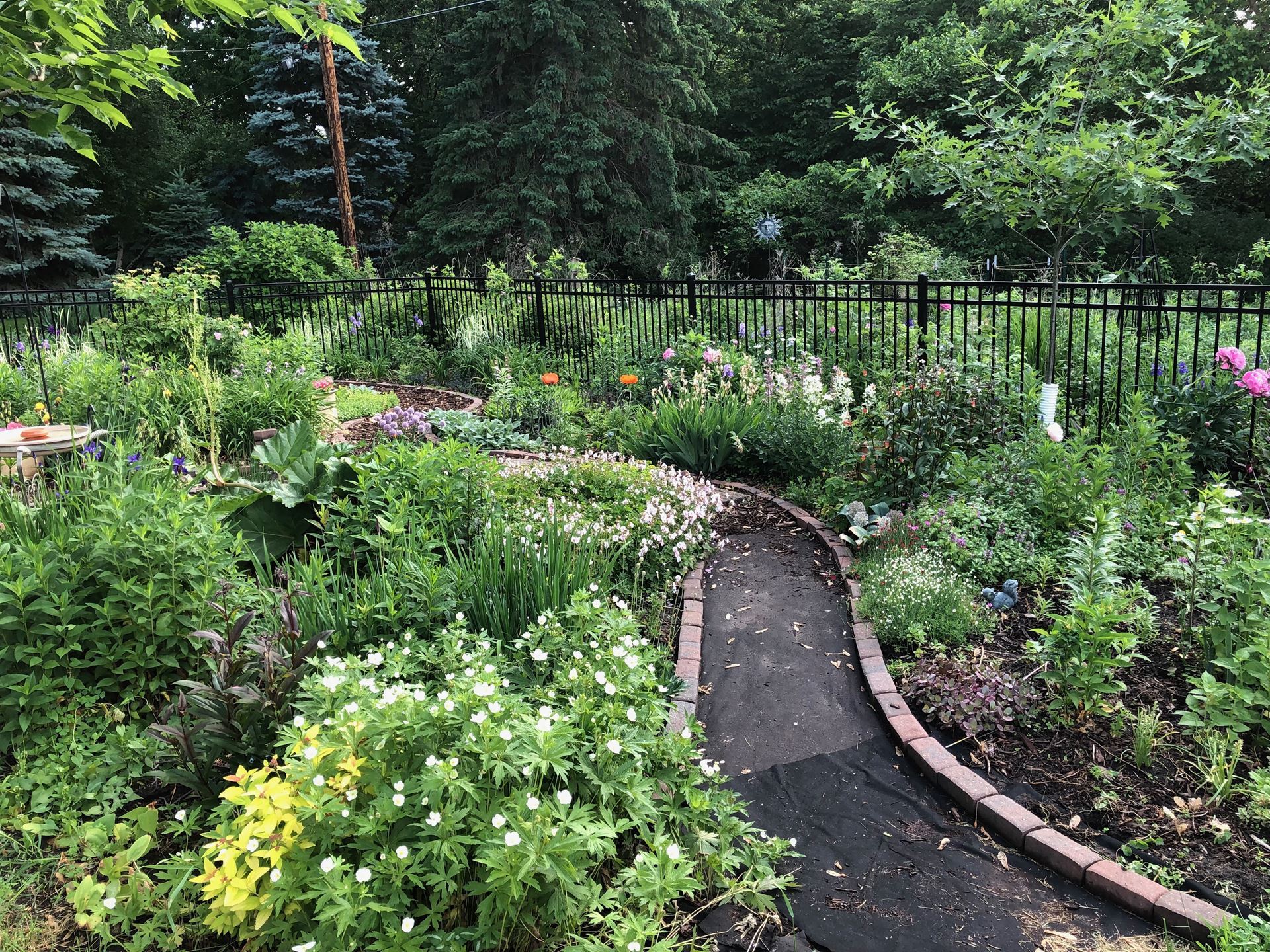 I just checked and Patio Town still offers the same 6.25” x 3” brick at $.58 cents each, or with sales tax $1.25 per linear foot. The new extended walkway will be 10’ to 20’ long. To edge both sides, I will need 20 to 40 running feet of brick costing a total of $25 to $50.00. I can fit 100 bricks in my SUV, so I do not need to pay for delivery.
I just checked and Patio Town still offers the same 6.25” x 3” brick at $.58 cents each, or with sales tax $1.25 per linear foot. The new extended walkway will be 10’ to 20’ long. To edge both sides, I will need 20 to 40 running feet of brick costing a total of $25 to $50.00. I can fit 100 bricks in my SUV, so I do not need to pay for delivery.
Plant Selection: Last month, I covered how to do a plant species search with the Prairie Moon website, and I pointed to websites that list additional suppliers. Some of these vendors are closer to, or they travel to the Twin Cities for native plant markets. Prices will vary and you would not have to pay for shipping.
The Burnsville Native Plant Market is on May 20. Their website includes links to vendors that will be at that market. Each vendor website has a list of species and prices. Most, but not every species is native to the Twin Cities. These sales tend to be crowded and plants can sell out, so you may want to pre-order. Not all vendors offer the ability to pre-order.
At the Blazing Star Gardens website, I also found dates for native plant markets in Edina and Oakdale. These sales will have multiple vendors but I could not yet find websites for those plant markets.
The size of the plugs/pots may vary. The smaller the plug, the less expensive it is, but the more care (watering) it may require in the first few weeks. The later the sale, the longer the plant has had to grow and develop roots, but the more likely the selection will be picked over.
Sue’s Plant Selection Plan: From the results of my search, I have started a list of species for my garden. My list is too long, so I will scratch some species off after more research. My reasons to delete a species include being a favorite of rabbits, needing acidic soil (which I do not have), getting too tall, spreading too fast, or not being able to find a supplier. My reason to keep a species include that it is good for birds or pollinators, blooms for a long period of time, is well behaved, and I like the way it looks.
I am trying to fit my native plants into a front yard surrounded by well-manicured lawns, so I will try to make it look more like a garden bed and less like a wild prairie. I will group multiple plants of each species together. I need to decide how many of each species makes a nice size grouping. Because Prairie Moon has a huge plant selection, I will likely purchase some plugs from them.
I have been to several local native plant markets and really enjoy the energy but find them crowded and probably not the place to decide what you want. I plan to pre-order additional plugs, most likely from a vendor that will be at the Burnsville Plant Market where I will go pick them up.
Jumping Worms - Mulch, Compost, Soil and Plant Exchanges: An invasive species called jumping worms is now in our area. Jumping worms are terrible and you don’t want them. They eat everything and will turn your soil to loose coffee grounds. They can be brought to your yard as adult worms or as tiny eggs in soil, compost, or mulch. Plant exchanges in our area are being curtailed because jumping worms can be spread in the soil of plants you exchange. The plugs you purchase will likely be grown in a greenhouse where you are less likely to get jumping worms. You may want to ask the vendor about their materials and process. The most common control is heat treating the material. For example, making sure that compost or soil reaches a temperature that will kill the jumping worms and their eggs.
More info on jumping worms:
MN DNR
University of Minnesota Extension
Video example of jumping worm - U of M project website
Sue’s Mulch, Compost, Soil and Plant Exchange Plan: Because of jumping worms, I do not plan to bring compost or soil into my yard. I will purchase plugs from well-known growers, and I will make my own mulch from an area that has no known jumping worms. I stopped exchanging plants with friends several years ago, but I continue to exchange seeds.
For next month - Some decisions - to order plugs in April, or pick them up in May or June, you will want to know the number of plants you need. After the snow melts, you will want to tape measure or step off the size of your garden area. Keep in mind that things may still change. For example, you may have underground utilities marked and decide not to plant on top of them; you may run into concrete or a boulder just below the soil surface; or the plant vendors may sell out of one of the species you want. Then you create Plan B because lots of options will work out well.